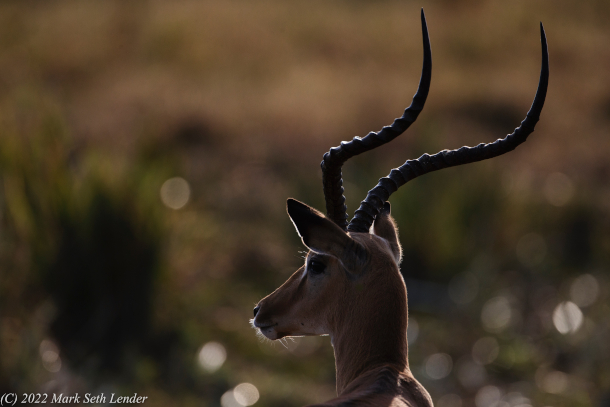Field Note: The Impala Imperative
Published: March 11, 2022
By Mark Seth Lender

An impala's graceful, curving horns (Photo: (c) Mark Seth Lender)
Living on Earth's Explorer-in-Residence Mark Seth Lender provides additional insight on how impala markings help confound predators and buy the antelope crucial extra time to escape.
For strategic reasons predators attack from behind. Confounding which end is which gives impala a better chance since the predator (especially those that are young and inexperienced) may attack the wrong end, the end that sees it coming. In the case of impala there is another and very particular piece of camouflage.
On an impala buck, just at the crease of thigh and body is a round dark oval mark reminiscent of an eye. When impala dip their heads to graze and that dot is at the level of their true and actual eyes, that is exactly what it looks like. An impala’s eye in the wrong place. With luck the predator’s resulting disorientation becomes that sought-after hesitation. Which may prove the difference, between discovery (by prey of predator) and surprise (by predator of prey) and thus impose the critical divide, between capture and escape.
No defense is perfect. Impala deceptive camouflage is apparent in broad daylight. It may work better at dusk or as light diminishes, it may not work at all. And of course from above it is useless.
Leopards are powerful. Like all cats their size-to-strength ratio is enormous. At five or six meters from the trees, the impala of this story were within range of that completely silent leopard. Even if she could not make the back or neck of one of them in a single leap, she would definitely be there on the rebound. One-two! All in a blur. And all advantage would be hers.
As to defenses overall, what deceives young predators will inevitably fail as experience reveals the magician’s tricks. That said, high juvenile mortality rates mean there are far more young than adult predators. What the young lack in experience they make up in numbers. More of them are out there hunting making them as deadly in the collective as their more skilled though less numerous parents. Impala camouflage has its moment.
Why the impala did not anticipate the potential for danger overhead– from leopards of any age - is hard to comprehend. Perhaps the distance they maintained from the woods was sufficient. I don’t think so but I’ll never know. We left for Nairobi before the sun was up, just after I saw the dark running shape of that leopard.
Back to Mark Seth Lender Field Notes
Links
Living on Earth wants to hear from you!
Living on Earth
62 Calef Highway, Suite 212
Lee, NH 03861
Telephone: 617-287-4121
E-mail: comments@loe.org
Newsletter [Click here]
Donate to Living on Earth!
Living on Earth is an independent media program and relies entirely on contributions from listeners and institutions supporting public service. Please donate now to preserve an independent environmental voice.
NewsletterLiving on Earth offers a weekly delivery of the show's rundown to your mailbox. Sign up for our newsletter today!
 Sailors For The Sea: Be the change you want to sea.
Sailors For The Sea: Be the change you want to sea.
 The Grantham Foundation for the Protection of the Environment: Committed to protecting and improving the health of the global environment.
The Grantham Foundation for the Protection of the Environment: Committed to protecting and improving the health of the global environment.
 Contribute to Living on Earth and receive, as our gift to you, an archival print of one of Mark Seth Lender's extraordinary wildlife photographs. Follow the link to see Mark's current collection of photographs.
Contribute to Living on Earth and receive, as our gift to you, an archival print of one of Mark Seth Lender's extraordinary wildlife photographs. Follow the link to see Mark's current collection of photographs.
 Buy a signed copy of Mark Seth Lender's book Smeagull the Seagull & support Living on Earth
Buy a signed copy of Mark Seth Lender's book Smeagull the Seagull & support Living on Earth

